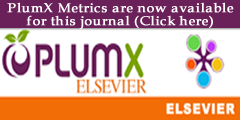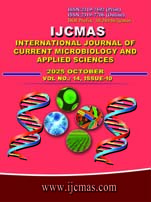


 National Academy of Agricultural Sciences (NAAS)
National Academy of Agricultural Sciences (NAAS)

|
PRINT ISSN : 2319-7692
Online ISSN : 2319-7706 Issues : 12 per year Publisher : Excellent Publishers Email : editorijcmas@gmail.com / submit@ijcmas.com Editor-in-chief: Dr.M.Prakash Index Copernicus ICV 2018: 95.39 NAAS RATING 2020: 5.38 |
The present study was conducted in bread wheat (Triticum aestivum L. em. Thell.) to estimate heterosis for fifteen quantitative traits using a 10 × 10 half-diallel (excluding reciprocals), comprising 45 F?s, 10 parents, and two standard checks, evaluated across three environments during Rabi 2020-21. Analysis of variance revealed significant genotypic differences for all traits, and pooled analysis (11 traits) confirmed significant environmental influence on heterosis expression. For grain yield per plant, heterosis over the better parent was expressed by 8, 8, 5, and 10 crosses in E1, E2, E3, and pooled analysis, respectively. MP1203 × DBW187 showed the highest heterosis in E1, E3, and pooled data, while Raj4238 × DBW187 was superior in E2. Economic heterosis over the standard check ‘Sonalika’ was recorded in 1, 8, 8, and 8 crosses, with Raj4238 × Raj3077 (E1), HD3086 × WR544 (E2, pooled), and HI1544 × Raj4079 (E3) exhibiting maximum values. For biological yield per plant, 18-21 crosses showed better parent heterosis, led by MP1203 × WR544, while 23-29 crosses surpassed the standard check, with HI1544 × WR544 and HD3086 × Raj4079 being most promising. Five crosses, HD3086 × WR544, Raj4238 × WR544, Raj4238 × Raj3077, HD3086 × Raj4079, and Raj4238 × Raj4079, consistently combined high yield and economic heterosis with desirable yield traits, indicating strong potential for commercial exploitation and wheat improvement programmes.
Abdullah, G. M., Khan, A. S. and Ali, Z. 2002. Heterosis study of certain important traits in wheat. International Journal of Agriculture and Biology, 4(3): 326-328.
Anonymous. 2021. Progress report of All India Co-ordinate Wheat and Barley Improvement Project 2020-21. Crop Improvement, ICAR-Indian Institute of Wheat and Barley Research, Karnal, India. pp-227.
Baloch, M., Baloch, A. W., Siyal, N. A., Baloch, S. N., Soomro, A. A., Baloch, S. K. and Gandhi, N. 2016. Heterosis analysis in F1 hybrids of bread wheat. Sindh University Research Journal (Science Series), 48(2): 261-264.
Birchler, J. A., Yao, H., Chudalayandi, S., Vaiman, D. and Veitia, R. A. 2010. Heterosis. Plant Cell, 22(7): 2105-2112. https://doi.org/10.1105/tpc.110.076133
Devi, E. L., Swati, Goel, P., Singh, M. and Jaiswal, J. P. 2013. Heterosis studies for yield and yield contributing traits in bread wheat (Triticum aestivum L.). The Bioscan, 8(3): 905-909.
Desale, C. S. and Mehta, D. R. 2013. Heterosis and combining ability for grain yield and quality traits in bread wheat (Triticum aestivum L.). Electronic Journal of Plant Breeding, 4(3): 1205-1213.
Dhoot, M., Sharma, H., Badya, V. K. and Dhoot, R. 2020. Heterosis for earliness and heat tolerant traits in bread wheat (Triticum aestivum L.) over the environments. International Journal of Current Microbiology and Applied Sciences, 9(3): 624-630.
Easterly, A. C., Stroup, W. W., Garst, N., Belamkar, V., Sarazin, J. B., Moittie, T., Ibrahim A. M. H., Rudd, J. C., Souza, E. and Baenziger, P.S. 2019. Determining the efficacy of a hybridizing agent in wheat (Triticum aestivum L.). Scientific Reports, 9, 20173 (2019). https://doi.org/10.1038/s41598-019-56664-9.
Griffing, B. 1956a. A generalized treatment of the use of diallel crosses in quantitative inheritance. Heredity, 10: 31-50.
Fonseca, S. and Patterson, F. L. 1968. Hybrid vigour in seven-parental diallel crosses in common winter wheat (Triticum aestivum L.). Crop Science, 8: 85-88.
Ismail, K. A. S. 2015. Heterosis and combining ability analysis for yield and its components in bread wheat (Triticum aestivum L.). 4(8): 1-9.
Kempe, K., Rubtsova, M. and Gils, M. 2014. Split-gene system for hybrid wheat seed production. PNAS, 111(25): 9097-9102.
Kumar, D., Panwar, I. S., Singh, V., Choudhary, R. R. and Samita. 2020. Heterosis studies using Diallel analysis in bread wheat (Triticum aestivum L.). International Journal of Chemical Studies, 8: 2353-2357.
Kumari, M. 2022. Heterosis, combining ability, stability analysis and molecular profiling in bread wheat [Triticum aestivum (L.) em. Thell. [Doctoral thesis, Maharana Pratap University of Agriculture and Technology]. Krishikosh.
Kumari, M., Sharma, H., Dadheech, A. and Dashora, A. 2025a. Molecular characterization and genetic diversity assessment of bread wheat [Triticum aestivum (L.) em. Thell] genotypes using SSR markers. International Journal of Current Microbiology and Applied Sciences, 14(5):139-147. https://doi.org/10.20546/ijcmas.2025.1405.014.
Kumari, M., Sharma, H., Dadheech, A., Dashora, A. and Verma. M. 2025b. Evaluation of genotypic stability and adaptability in bread wheat [Triticum aestivum (L.) em. Thell] under southern Rajasthan conditions. International Journal of Current Microbiology and Applied Sciences, 14(7):56-67. https://doi.org/10.20546/ijcmas.2025.1407.007.
Mahpara, S., Ali, Z., Farooq, J., Hussain, S. and Bibi, R. 2015. Heterosis and heterobeltiosis analysis for spike and its attributes in different wheat crosses. Pakistan Journal of Nutrition, 14(7): 396-400.
Meredith, W. R. and Bridge, R. R. 1972. Heterosis and gene action in cotton (Gossypium hirsutam). Crop Science, 12: 304-310.
Pena, R. J., Espinosa, N. H., Jones, J. M., Guzman, C. and Braun, H. J. 2017. CIMMYT series on carbohydrates, wheat, grains, and health: Wheat-based foods: their global and regional importance in the food supply, nutrition, and health. Cereal Foods World, 62(5): 231-249.
Rahul, S. R. 2017. Combining ability and heterosis for morpho-physiological characters on bread wheat (Triticum aestivum L.). Agricultural Research& Technology Open Access Journal, 13(1): 003-0010.
Raiyani, A. M., Kapadia, V. N., Boghara, M. C., Bhalala, K. C. and Patel, D. U. 2016. Estimation of heterosis in different crosses of bread wheat (Triticum aestivum L.). The Bioscan, 11(2): 1117-1121.
Rajput, R. S. and Kandalkar, V. S. (2018). Combining ability and heterosis for grain yield and its attributing traits in bread wheat (Triticum aestivum L.). Journal of Pharmacognosy and Phytochemistry, 7(2): 113-119.
Saren, D., Mandal, A. B. and Soren, C. 2018. Heterosis studies in bread wheat (Triticum aestivum L.). IOSR Journal of Agriculture and Veterinary Science, 11(9): 80-84.
Singh, H., Sharma, S. N. and Sain, R. S. 2004. Heterosis studies for yield and its components in bread wheat over environments. Hereditas, 141(2): 106-114.
Swelam, D. A., Ali, M. A., Hassan, A. M. and Salem, A. H. 2014. Selection criteria for improving wheat grain yield under normal irrigation and drought stress environments. Zagazig Journal of Agriculture Research, 41(4): 695-704. |
 |
 |
 |
 |